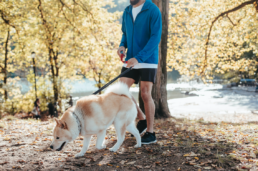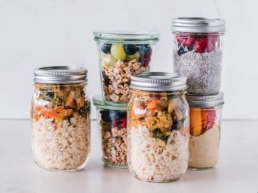By Kathy Gregory, First Mile Care DPP Coach
Learning to make more nutritious choices in the foods and drinks you consume is key to adopting a healthy lifestyle. As part of the Diabetes Prevention Program (DPP) curriculum, First Mile Care coaches teach participants how to track their intake and become more aware of portion size and the high calorie and highly processed foods to limit. The goal is to increase awareness of how eating smaller portions of higher quality foods as part of a balanced diet can satisfy hunger and improve wellness.
When navigating the grocery store, examine packaging carefully before you decide on a purchase. Generally, the statements on the front of a package are marketing claims, while the back or side has factual information. By checking the nutrition facts label, you can make more informed choices. If you’re trying to lose weight, you’ll be mindful of how many calories you eat, and how many are from sugar and fat. If you have high blood pressure, you’ll look at salt content. It may take a bit longer to do your shopping, but when you pull an item from the cupboard at home, you’ll know it was the best option available.
First Mile Care participant Jeannie Lawson was shocked at the high calorie and fat content listed on labels. “It has made me very conscious of what I put in my mouth and has changed how I do my grocery shopping. Now when I am in the store, I use a smartphone app called Lose It!, which reads the barcode and tells me the label information. It helps me with tracking what I consume and deciding if I really want to buy that food item with high calorie or carbohydrate or salt count.”
Servings versus portions
For anyone seeking to monitor their calorie intake or consumption of different proteins and vitamins, the serving sizes listed on nutrition labels can guide you in the right direction. All the nutrient amounts on the label are based on the serving size. The serving size reflects a standard quantity chosen for measurement and is not a specific recommendation of how much you should consume of the item.
It’s easy to misread and misinterpret nutritional labels, and they are not infallibly exact. As per the FDA guidelines, “FDA’s continuing policy since the 1970s assigns the manufacturer the responsibility for assuring the validity of a product label’s stated nutrient values.” What’s more, the average size of some food items, especially produce, is larger today than when the standard serving measurements were developed years ago. Bananas, for example, come from mini to giant sized, and chicken breasts are larger than they used to be.
What can be confusing is that while a serving is what is stated on the package, it may not be the amount that you would normally eat of a particular item — what’s called a portion. Therefore, it’s critical to look at the number of servings in the package. It’s OK to eat more than a serving, as long as you are aware that you are also consuming multiples of calories and nutrients, too.
For example, according to the packaging on a Top Ramen brick of noodles, a serving is just half the brick, even though most people will consume the entire brick as their portion. The label on a can of soup or chili or clam chowder, or a packaged Indian dinner, or boxed pasta, may also say it’s multiple servings, even though the actual quantity that will satisfy you is the entire package.
If you eat two servings, you need to double all the quantities in the nutrition facts. So if a serving has 150 calories but you ate two servings, you actually ate 300 calories. For example, the nutrition label on a package of rice says that a serving is half a cup, but most people would consume more than that amount in a single sitting. If your portion is one cup of rice, that is two of your recommended servings of grains for the day.
Another food item whose serving size is easily misunderstood is breakfast cereal. Most people just eyeball the amount of corn flakes or granola poured into a bowl. If you read the serving size listed on the label, you may find you’re eating double or even triple the serving — as well as the sugar and calories.
The confusion doesn’t end with food. Some beverages, like Gatorade and some brands of kombucha, contain more than one serving in a single small can or bottle.
Achieving balance
Calories provide a measure of how much energy you get from a serving of a food item, and the number of servings you eat determines the number of calories you consume. Balancing the number of calories you eat and drink with the number of calories your body burns through daily activity is a stepping stone to achieving a healthy body weight. Your estimated calorie needs may be higher or lower and vary depending on your age, sex, height, weight, and physical activity level.
As First Mile Care participant Al Cisneros explains, “I never used to look at food labels or packaging. When my wife asked me to pick up bread and butter at the grocery store, I grabbed the first thing I saw. I never considered basing my choices on sodium and fat and carbohydrate levels. My First Mile Care DPP coach, Sandra Huskey, encouraged us to read labels carefully, track calories in our food journals or apps, and make wise decisions based on whether an item is really worth how long it will take to burn off the calories.”
Labels also show how much a nutrient in a single serving contributes to the percentage of Daily Value (%DV) reference amount of nutrients to consume (or not to exceed) in a recommended daily diet. You can use the %DV figure to gauge how a food’s nutrients stack up and which nutrients to consume more, and which to consume less.
Five ingredients or less
Nutrition labels sometimes seem written in a foreign language. The rule of thumb for labels on healthier food items is five ingredients or less, if possible. You want to see words that you recognize as ingredients instead of the names of dyes, fillers, preservatives, and chemicals. Whole foods like produce, legumes, lean meat, eggs, whole grains, nuts, and seeds generally have fewer ingredients so there’s less uncertainty about what you’re putting in your mouth.
Some nutrients are better in smaller amounts. Many ultra-processed packaged foods include added fat, sugar, salt, and preservatives. Eating too much fat, especially saturated fat or trans fat, cholesterol, added sugars, or sodium can raise your risk of health problems such as heart disease and high blood pressure. On the flip side, there are nutrients such as fiber, vitamins, and minerals that can improve your health and lower your risk of certain health problems. Most Americans don’t get enough dietary fiber, vitamin A, vitamin C, calcium, or iron.
Nutrition labels caused First Mile Care participant Jeff Millhouse to re-evaluate the multi-day juice cleanses he used to do on a regular basis to help maintain his weight. “When I looked at the labels on several of the juices, I was surprised at the added sugar. This occurred with both the juice cleanse bundles and a healthy juice I bought at a local vegetarian restaurant. I’ve also changed the type of yogurt I buy, and look more closely at the sugars in cereals and packaged products.”
Knowledge is power
The First Mile Care Diabetes Prevention Program is centered on developing sustainable healthy changes to diet and fitness, without giving up the foods you enjoy.
Nutrition labels pack a lot of useful information into a tiny box. They can guide you to become a smarter grocery shopper (and eater). As First Mile Care participant Katherine Dowling advises, “Whoever is doing the grocery shopping should be studying that, especially if you’re buying something that is pre-made. It’s a way to keep yourself on the straight and narrow.”
To learn more about how you can benefit from the First Mile Care Diabetes Prevention Program, take the prediabetes risk test and get started today!



